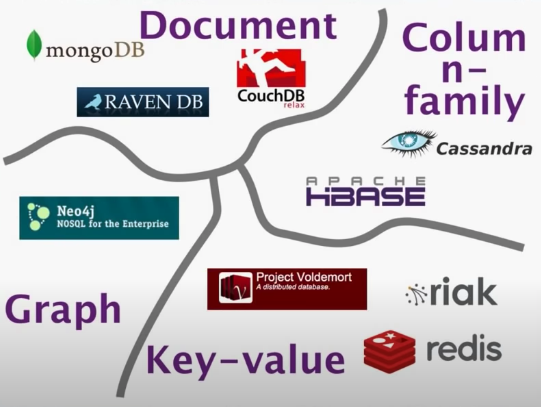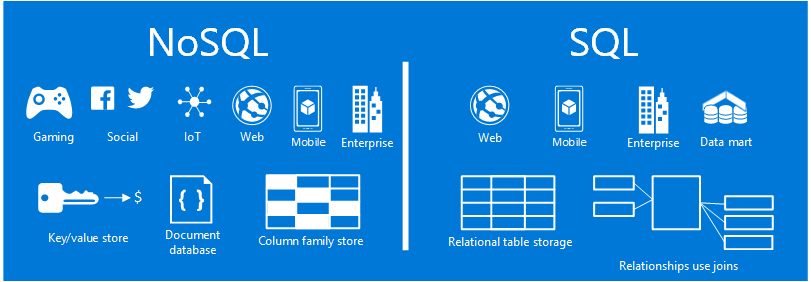# NoSQL Overview
# Definition
There's no strong definition of the concept out there, no trademarks, no standard group, not even a manifesto.
Some characteristics are common amongst these databases, but none are definitional.
- Not using the relational model (nor the SQL language)
- Open source
- Designed to run on large clusters
- Based on the needs of 21st century web properties
- No schema, allowing fields to be added to any record without controls
# Why NoSql?
- Relational databases have been a successful technology for twenty years, providing persistence, concurrency control, and an integration mechanism.
- Application developers have been frustrated with the impedance mismatch between the relational model and the in-memory data structures.
- There is a movement away from using databases as integration points towards encapsulating databases within applications and integrating through services.
- The vital factor for a change in data storage was the need to support large volumes of data by running on clusters. Relational databases are not designed to run efficiently on clusters.
- NoSQL is an accidental neologism. There is no prescriptive definition—all you can make is an observation of common characteristics.
- The most important result of the rise of NoSQL is Polyglot Persistence.
# Data Models

- Document
- Column-family
- Key-value
- Graph
# Aggregate Data Model
An aggregate is a collection of data that we interact with as a unit. Aggregates form the boundaries for ACID operations with the database.
Key-value, document, and column-family databases can all be seen as forms of aggregate-oriented database.
Aggregates make it easier for the database to manage data storage over clusters.
Aggregate-oriented databases work best when most data interaction is done with the same aggregate; aggregate-ignorant databases are better when interactions use data organized in many different formations.
# Distribution Models
There are two styles of distributing data:
- Sharding distributes different data across multiple servers, so each server acts as the single source for a subset of data.
- Replication copies data across multiple servers, so each bit of data can be found in multiple places.
A system may use either or both techniques.
Replication comes in two forms:
- Master-slave replication makes one node the authoritative copy that handles writes while slaves synchronize with the master and may handle reads.
- Peer-to-peer replication allows writes to any node; the nodes coordinate to synchronize their copies of the data.
Master-slave replication reduces the chance of update conflicts but peer-to-peer replication avoids loading all writes onto a single point of failure.
# Row oriented vs. Column oriented
| Row oriented DB | Column oriented DB |
|---|---|
| stored and retrieved one row at a time and hence could read unnecessary data if some of the data in a row are required. | stored and retrieve in columns and hence it can only able to read only the relevant data if required. |
| Records are easy to read and write. | Read and write operations are slower as compared to row-oriented. |
| best suited for online transaction system. | best suited for online analytical processing. |
| These are not efficient in performing operations applicable to the entire datasets and hence aggregation in row-oriented is an expensive job or operations. | These are efficient in performing operations applicable to the entire dataset and hence enables aggregation over many rows and columns. |
| Typical compression mechanisms which provide less efficient result than what we achieve from column-oriented data stores. | These type of data stores basically permits high compression rates due to little distinct or unique values in columns. |
# Comparison
# Sql vs. NoSql

| NoSQL | SQL | |
|---|---|---|
| Model | Non-relational | Relational |
| Stores data in JSON documents. key/value pairs, wide column stores, or graphs | Stores data in a table | |
| Data | Offers flexibility as not every record needs to store the same properties | Great for solutions where every record has the same properties |
| New properties can be added on the fly | Adding a new property may require altering schemas or backfilling data | |
| Relationships are often captured by denormalizing data and presenting all data for an object in a single record | Relationships are often captured in normalized model using joins to resolve references across tables | |
| Good for semi-structured, complex or nested data | Good for structured data | |
| Schema | Dynamic or flexible schemas | Strict schema |
| Database is schema-agnostic and the schema is dictated by the application. This allows for agility and highly itertive development | Schema must be maintained and kept in sync between application and database | |
| Transactions | ACID transaction support varies per solution | Supports ACID transactions |
| Consistency & Availability | Eventual to strong consistency supported, depending on solution | Strong consistency enforced |
| Consistency, availability, and performance can be traded to meet the needs of the application (CAP theorem) | Consistency is prioritized over availability and performance | |
| Performance | Performance can be maximized by reducing consistency, if needed | Insert and update performance is dependent upon how fast a write is committed, as strong consistency is enforced. Performance can be maximized by using scaling up available resources and using in-memory structures. |
| All information about an entity is typically in a single record, so an update can happen in one operation | Information about an entity may be spread across many tables or rows, requiring many joins to complete an update or a query | |
| Scale | Scaling is typically achieved horizontally with data partitioned to span servers | Scaling is typically achieved vertically with more server resources |
- SQL: Structured Query Language
- UnQL: Unstructured Query Language
- ACID: Atomicity, Consistency, Isolation and Durability
- CAP: Consistency, Availability and Partition tolerance